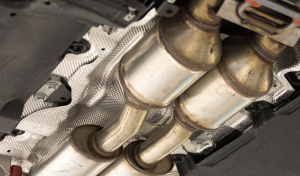The fine internal meshwork of your catalytic converter does a wonderful job of cleaning your engine’s fumes. Cats are also remarkably durable. In all likelihood, your cat will last a good ten years of driving. But eventually, most cats run into trouble, so here are four signs that it’s time to visit your Lexus service center for a new one.
Check Engine Light
Malfunctioning cats back up the flow of fumes and air, which causes problems in the engine. Your vehicle’s sensors will quickly detect that something’s wrong and alert you with the check engine light on your dashboard. You won’t immediately know specifically what’s causing the check engine light to come on. But if you also notice one or two of the following issues, you might safely guess that your cat is the culprit.

Reduced Engine Power
When the airflow becomes somewhat clogged, the fuel-air mixture inside the combustion chambers becomes unbalanced. This means your cylinders won’t be firing as efficiently, and you’ll notice a reduction in engine power.
When you press your foot on the gas pedal, you won’t be responding with quite as much oomph as before. You’ll probably find your car idling roughly and noisily as it misfires and struggles to stay alive. You’ll have diminished gas mileage. You might even have trouble accelerating quickly enough to overtake another vehicle.
Metallic Rattling From Below
When the meshwork inside a cat becomes degraded, it often starts to fall apart. You can sometimes hear the loose pieces rattling around inside the cat below your car, especially when cornering.
Any external impact on the cat can also damage the interior, or even knock the whole cat loose in its brackets. In this case, the rattling will be a lot louder. If you hear it, pull over and check to see if your cat’s been dented or visibly loosened.
Strong Stink of Sulfur
One warning sign not to be ignored is the strong sulfury smell of rotten eggs. This smell often means your cat has stopped properly converting toxic emissions into more harmless gases.
Hydrogen sulfide is leaking out of the exhaust and into your cabin. This gas is poisonous to humans, so if you ever smell it, open all your windows and have a technician take a look right away.
How Your Lexus Dealer Will Inspect Your Catalytic Converter
The symptoms of cat trouble can have various causes. To diagnose the problem, the technician will first interface with your car’s onboard computer, which should give them some useful data. They’ll also detach exhaust piping upwind of the cat and run the engine to see if the engine problems resolve themselves when the cat’s out of action.
One other test is to use special tools to measure the temperature of the exhaust pipes before and after the cat. Cat problems almost always cause excessive heat as trapped emissions build up. If they diagnose a cat problem, they’ll attempt to repair it. But damaged cats usually need to be replaced.
Visit DARCARS Lexus of Silver Spring today to have your catalytic converter inspected if you suspect it might be time for a new one. Ready to learn more about maintaining and repairing your Lexus? Click here to explore similar blogs like this one!




